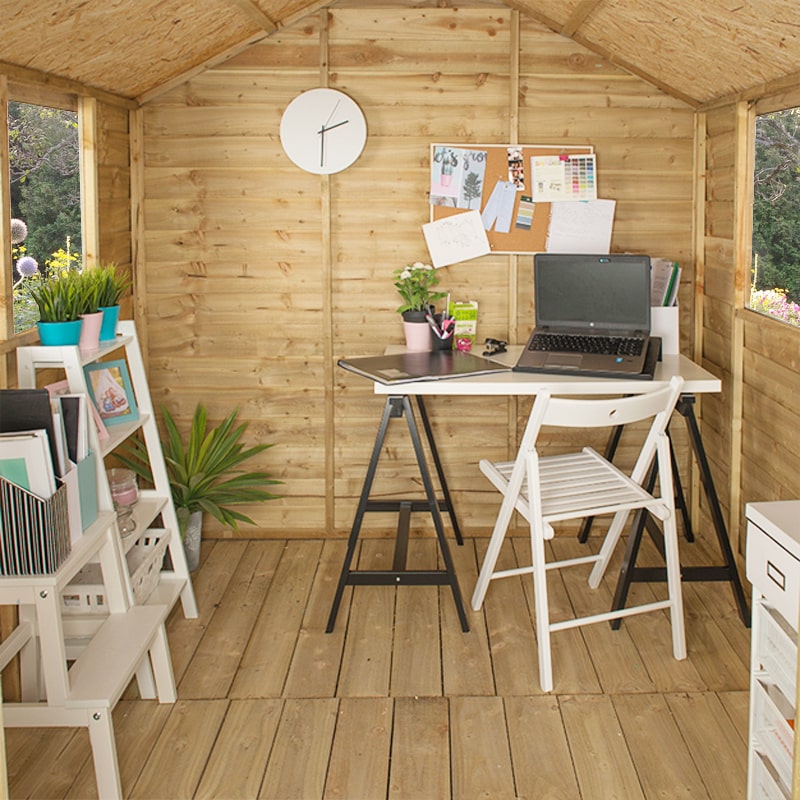Home working is becoming increasingly popular, especially when many companies and public sector employers are introducing desk sharing. Shedworking is not a new idea, as several writers and artists have taken to their sheds for solace in the past – most notably George Bernard Shaw worked from his revolving shed.
Some people are even lucky enough to have summerhouses or even log cabins, which can double up as an excellent working environment away from any distractions.
Working from home is an increasingly viable choice as most homes have extremely fast and reliable internet access.
The advantages are obvious, no tiresome commuting so you save on fares/tickets/petrol as well as saving you time. If you're running your own business from home, then you'll be saving on start-up costs and office rent while avoiding long tenancy commitments – Not to mention avoiding the noise and distractions of a busy office. Plus, if you work late then the journey home isn't affected.
There can also be fringe benefits from working at home, like roping family or household members in to help you out with the odd administrative job. Also, since you're at home, you can schedule your work life around your home life.
When considering home working, you'll need to think about the following:
- How are you going to effectively separate your home or family life from work?
- There could well be an initial expense of setting up
- Will there be many domestic distractions or family interruptions?
- Will you be able to cope with being isolated from your office?
So, what are the main options for the home worker:

1. Work in your own house / flat
Simply 'setting up shop' in your lounge or dining room may seem like an attractive choice, but there are disadvantages. For starters, do you have the room to take one room over to be your make-shift office? Also, the chance of distraction is greater as your home is a very different environment to your office, after all, we often go home to escape work.
There is a lot to be said for a physical separation between work and home. There are clear psychological benefits from commuting to a garden building for work. The separation helps to keep you focused on work and not on what's happening around you in your house.
2. Work from a purpose build garden building
An extension to your home or a purpose built bricks-and-mortar type of structure can be quite expensive, take a long time to complete and will need planning permission before you've even started. This isn't always the most cost effective option.
3. Upgrade your garden shed
If you already have a garden shed then the easiest option would be to use that as your garden office. Of course, you can't simply cram in power points and a computer and then call it an office, as you work surrounded by your garden tools, mower and a bunch of bikes. You will need to retrofit your shed so as it becomes a comfortable and habitable environment, conducive to working.
You may want to add extra windows to maximise natural light. Or you could even install a cheap skylight by replacing one roof panel with opaque / installing plastic sheeting. You should also insulate the walls, ceiling and floor to keep you warm in winter. Replacing your windows for double glazing will also help keep you heating costs down.
4. Buy a new large shed or log cabin
The last option is to get yourself a large shed which has been designed to be used as an office or extra social space. Simply choose the right style and size to suit your working life needs. If you opt for a log cabin, they will come with thick walls, double glazed windows and can have under floor heating systems effortlessly installed. They're generally quick to build and, in fact, you could have your new garden office built in a couple of days.
Once completed, your log cabin is versatile enough to be used for extra entertaining space at weekends. Some log cabins even have a nifty side compartment to be used as a shed, so you don't lose any storage space, should you replace an old shed with a new log cabin.
Since they're similar to a shed, you quite often don't need any planning permission but it is always a good idea to contact your local authority first.
Whatever option you choose, you'll soon be enjoying your 10 step commute to work and the relaxing, quiet atmosphere of your garden office shed. Even better, when you're done for the day you simply shut the door and you're home before you know it.
Find out how else log cabins can be used by watching our video below.
